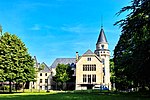Oberkassel Süd/Römlinghoven station
Bonn Straßenbahn stationsCologne-Bonn Stadtbahn stationsNorth Rhine-Westphalia railway station stubsPages with no open date in Infobox station

Oberkassel Süd/Römlinghoven is a Bonn Stadtbahn station served by lines 62 and 66. It is located in the suburb Oberkassel.
Excerpt from the Wikipedia article Oberkassel Süd/Römlinghoven station (License: CC BY-SA 3.0, Authors, Images).Oberkassel Süd/Römlinghoven station
Langemarckstraße, Bonn Bonn-Beuel
Geographical coordinates (GPS) Address Nearby Places Show on map
Geographical coordinates (GPS)
| Latitude | Longitude |
|---|---|
| N 50.7098 ° | E 7.1743 ° |
Address
Oberkassel Süd / Römlinghoven
Langemarckstraße
53227 Bonn, Bonn-Beuel
North Rhine-Westphalia, Germany
Open on Google Maps










